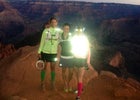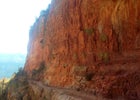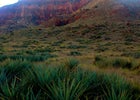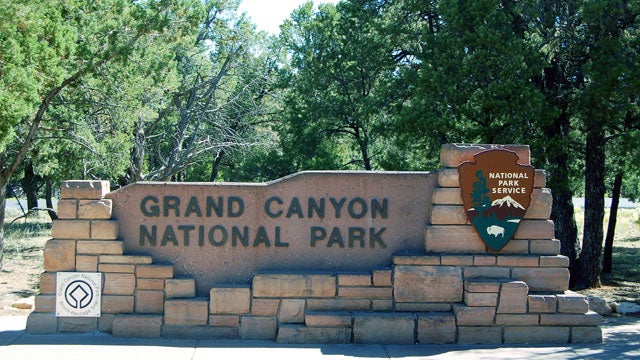Running 42 miles rim-to-rim across the Grand Canyon and back is arguably one of the best adventure trail runs in the country.
Just enjoy the scenery and the feeling of running through one of the most spectacular landscapes in the world.
 Katie, Meaghan, Anna.
Katie, Meaghan, Anna. North Kaibab Trail; don’t look down.
North Kaibab Trail; don’t look down. Yucca meadow.
Yucca meadow.Despite the burly mileage and nearly 11,000 feet in vertical climbing, if you’ve done your training and go prepared, it’s not as daunting as it sounds.
Here’s how to stage your own Grand Canyon double crossing.
DECIDE WHEN TO GO
The best running seasons are April through early May and October through November. Summer’s much too hot. Depending on weather conditions and spring storms, the top portions of the trails, particularly the North Kaibab, can be icy into April. updates its weather forecasts daily for both the South and North Rim and Phantom Ranch; the shares road conditions and park alerts.
CHOOSE YOUR ROUTE
At 42 miles, the South and North Kaibab Trails are the standard choice for runners going for speed and trying to set FKTs (fastest-known-times).
The other route to and from the South Rim, the Bright Angel Trail, is a bit longer but not quite as steep. It reaches the Colorado River in just over nine miles and has plenty of drinking water along the way. From there, follow North Kaibab to the North Rim and then retrace your steps. Total distance is about 46 miles.
Other considerations: The South Kaibab trailhead is about two miles from the hotels in Grand Canyon Village, whereas Bright Angel is just a few steps away.
BRING THE KIDS
When my husband, Steve, and I decided to run R2R2R together, my mother volunteered to babysit our two daughters at the South Rim. Then the government shutdown shuttered the Grand Canyon, and I had to reschedule without Steve.
But park closures are an anomaly, and a double crossing is a great excuse for a family trip. Kids will wig out at the sight of the Canyon, and depending on their age, may even hike a few miles below the Rim and back. They make an enthusiastic pre-dawn send-off crew, and knowing they’ll be eagerly awaiting your return at the South Rim will give you extra mojo on the long climb up from the river.
To keep kids busy while you run, check out the at the National Geographic Visitor Center in Tusayan; wander around the historic hotels right on the South Rim, including El Tovar and Bright Angel Lodge; prowl for souvenirs at the Hopi House (on our last trip, we picked up a couple of handmade cloth Navajo dolls for $10); or check out Grand Canyon photography and art exhibits at the at the Bright Angel trailhead.
FIND A PACK YOU LIKE
This is a self-supported, long-distance backcountry run, so you’ll need to carry all your own food. Water is available in several locations, but it’s best to carry some with you, in case taps are turned off or there’s an emergency. You’ll also need a pack in which to stash your fuel and other gear.
I wear the form-fitting women’s pack; it’s featherweight but roomy, and doesn’t bounce or jiggle. I was able to cram sports gels, a handful of energy blocks, a few bars, a peanut butter sandwich, and extra electrolytes in the various compartments (you’ll want to budget at least 200 calories per hour to stay ahead on your fuel). A small pocket holds a salt tablets, Ibuprofen, chocolate-covered espresso beans, and a tiny container of balm for sore muscles. The back pouch has room for a 1.5 liter hydration bladder, my super-light wind jacket, headlamp, and a map.
It’s always a good idea to test your gear, as well as your hydration and food strategies, over multiple training runs before the big day.
START EARLY
Most runners leave between 4 and 6 a.m., depending on their pace. We took off from the South Kaibab trail just after 6 a.m.—about 40 minutes before sunrise—on the last weekend in October. Twenty minutes in, we no longer needed our headlamps. If you anticipate posting a sub 12-hour time, start closer to sunrise and leave your headlamp at home.
A mule train typically leaves the South Kaibab trailhead between 5 and 6 a.m. (we ran into it almost immediately). If you’re not going for speed, don’t worry about starting before the mules. The wranglers will let you pass (eventually), and it won’t cost you more than a minute or two.
ROCK OUT
Many people diss wearing earbuds in the backcountry, claiming it isolates you from your surroundings and may even pose a safety risk. But I find the opposite to be true: When I listen to my iPod, I’m more present and aware of the environment around me because I’m listening rather than thinking. By drowning out the constant, annoying chatter in my head, I become more attuned to the world around me.
Ultrarunner Scott Jurek wrote in his book that listening to music when you run has the same effect as taking four Advil. For me, music takes the edge off the pain and brings the world into sharper focus.
I build my playlists from whatever songs I’m listening to at the moment: a little bit of this, a little bit of that, so I don’t get bored. Backcountry playlists are a little like ultrarunning: The songs don’t have to make sense, and they don’t have to be fast. You just have to like them. Here’s my R2R2R mix:
“” by Moby
“” by Tired Pony
“” by Avicii
“” by Rihanna
“” by Miranda Lambert
“” by Man Man
“” by Imagine Dragons
“” by Taylor Swift
“” by Fat Joe
“” by Gavin DeGraw
RUN FREE
Unless you’re going for a FKT—and maybe even if you are—leave your watch at home and turn your phone to airplane mode. It will still tell time, but it won’t drain the battery searching for a signal that doesn’t exist at the bottom of the Canyon. Whatever you do, try not to obsess over time. Just enjoy the scenery and the feeling of running through one of the most spectacular landscapes in the world.
EAT
After shoving down energy gels and blocks all day, you’ll be craving a real meal post R2R2R. On weekends during peak running season, the hotels and restaurants in Grand Canyon Village are crawling with visitors. To avoid an hours-long wait for dinner, make a reservation at Bright Angel Lodge’s steakhouse or the swanky ahead of time.
STAY
I booked a room at the inside the park, about a half-mile from Grand Canyon Village and a mile or so from both the Bright Angel and South Kaibab trailheads. The advantage to staying in the park is that you can walk or catch a shuttle to and from each trailhead.
There are also several hotels outside the park in nearby Tusayan, where rooms are comparable or slightly less expensive. Bonus: Unlike historic hotels inside the park—all of which are run by the concession Xanterra —hotels outside the park have hot tubs for soaking thrashed muscles.
For more Grand Canyon beta, check out Grand Canyon National Park online at .
For more on the author’s R2R2R journey, read “Running Rim-To-Rim-To-Rim.”


